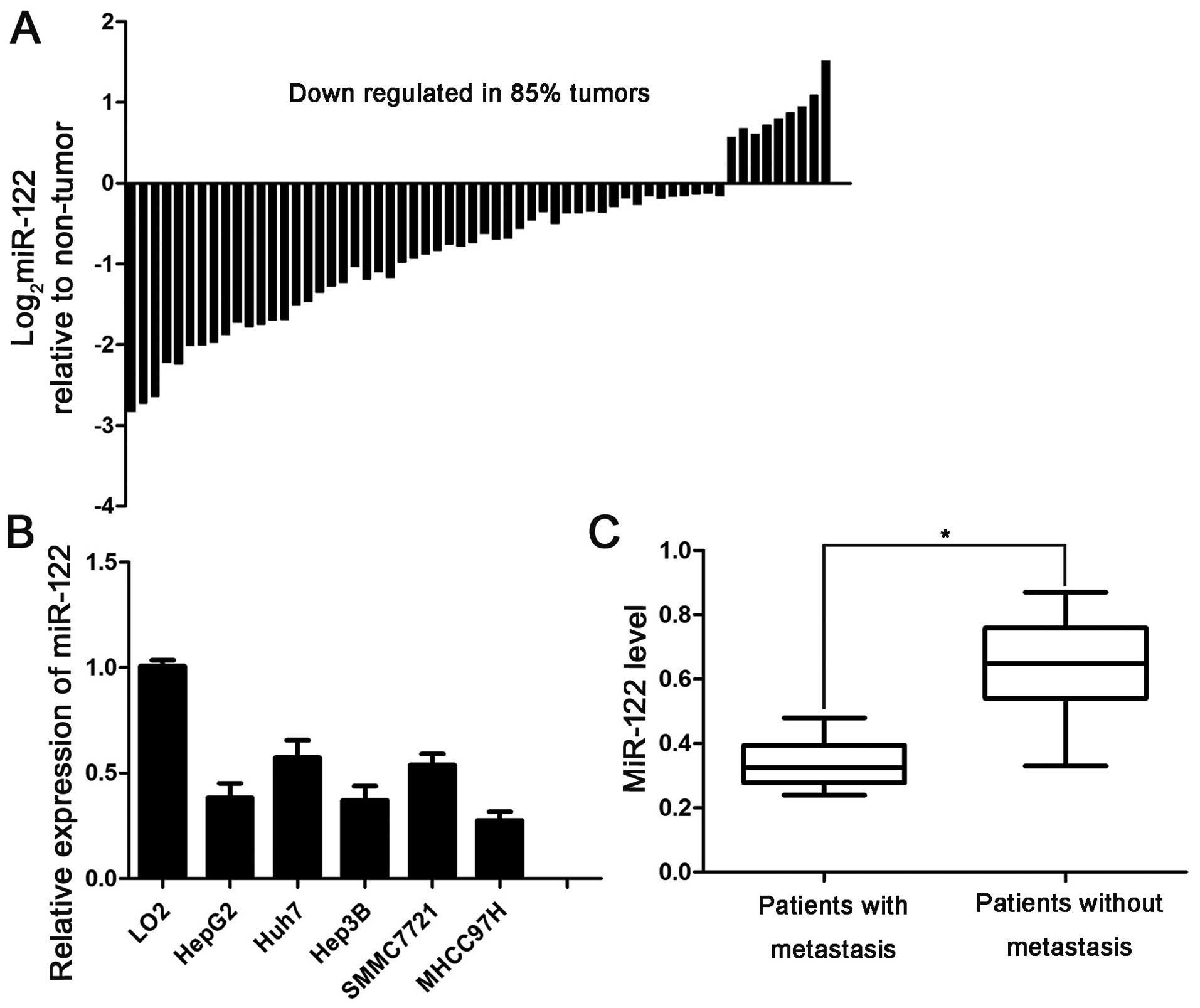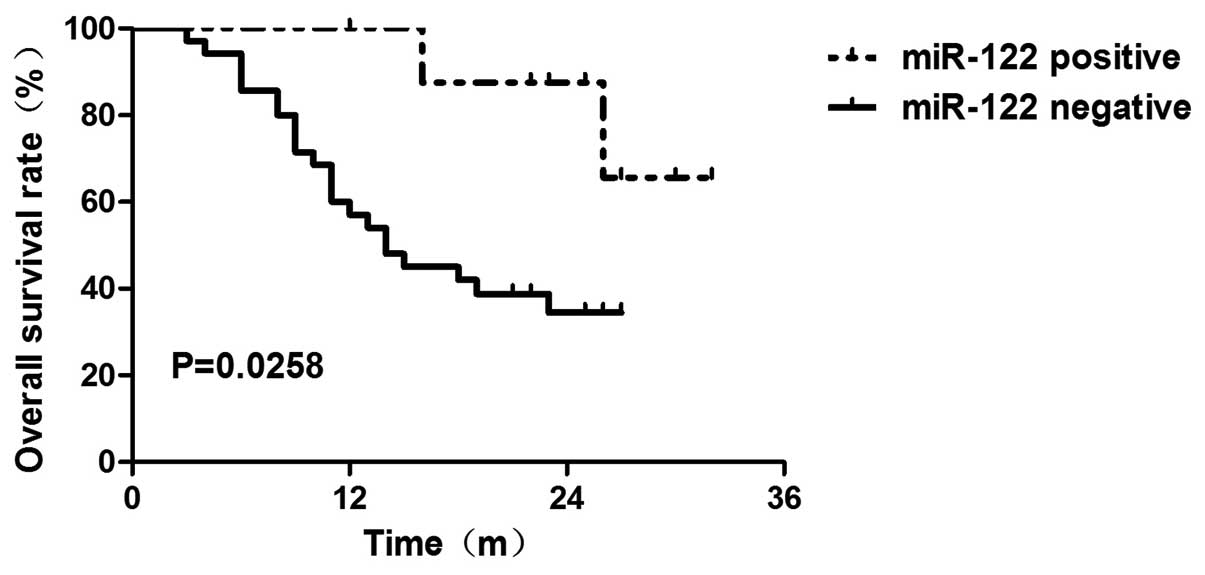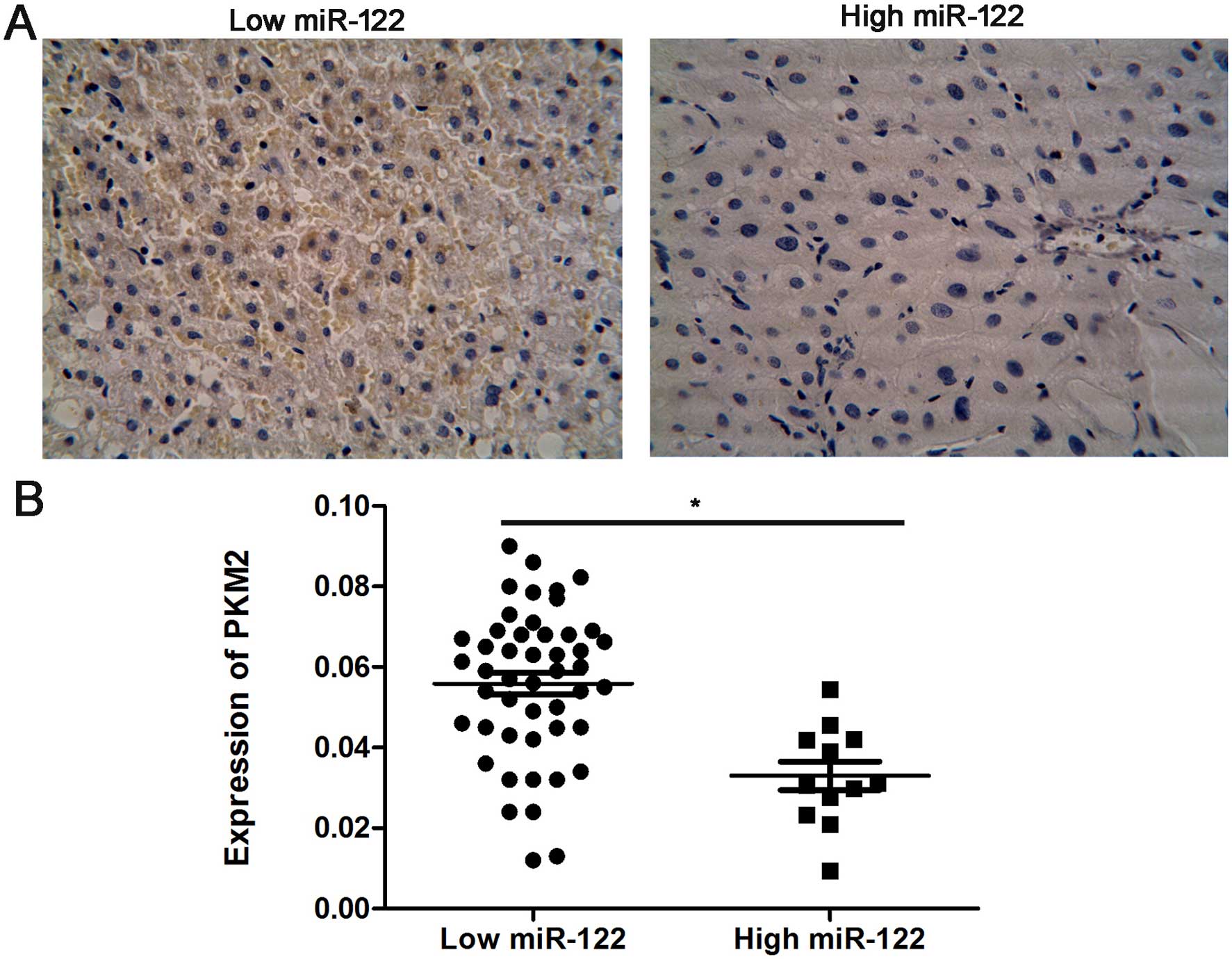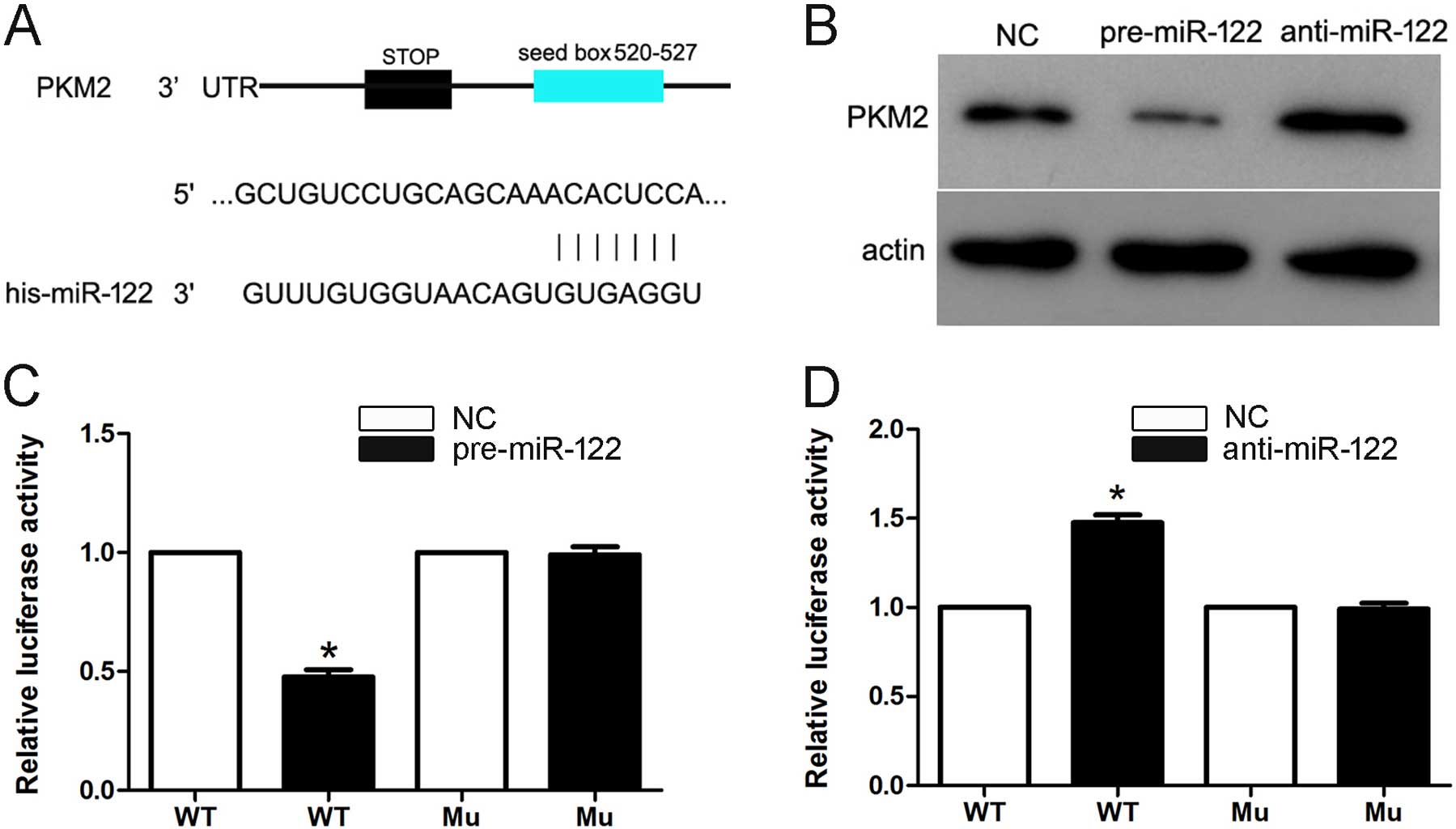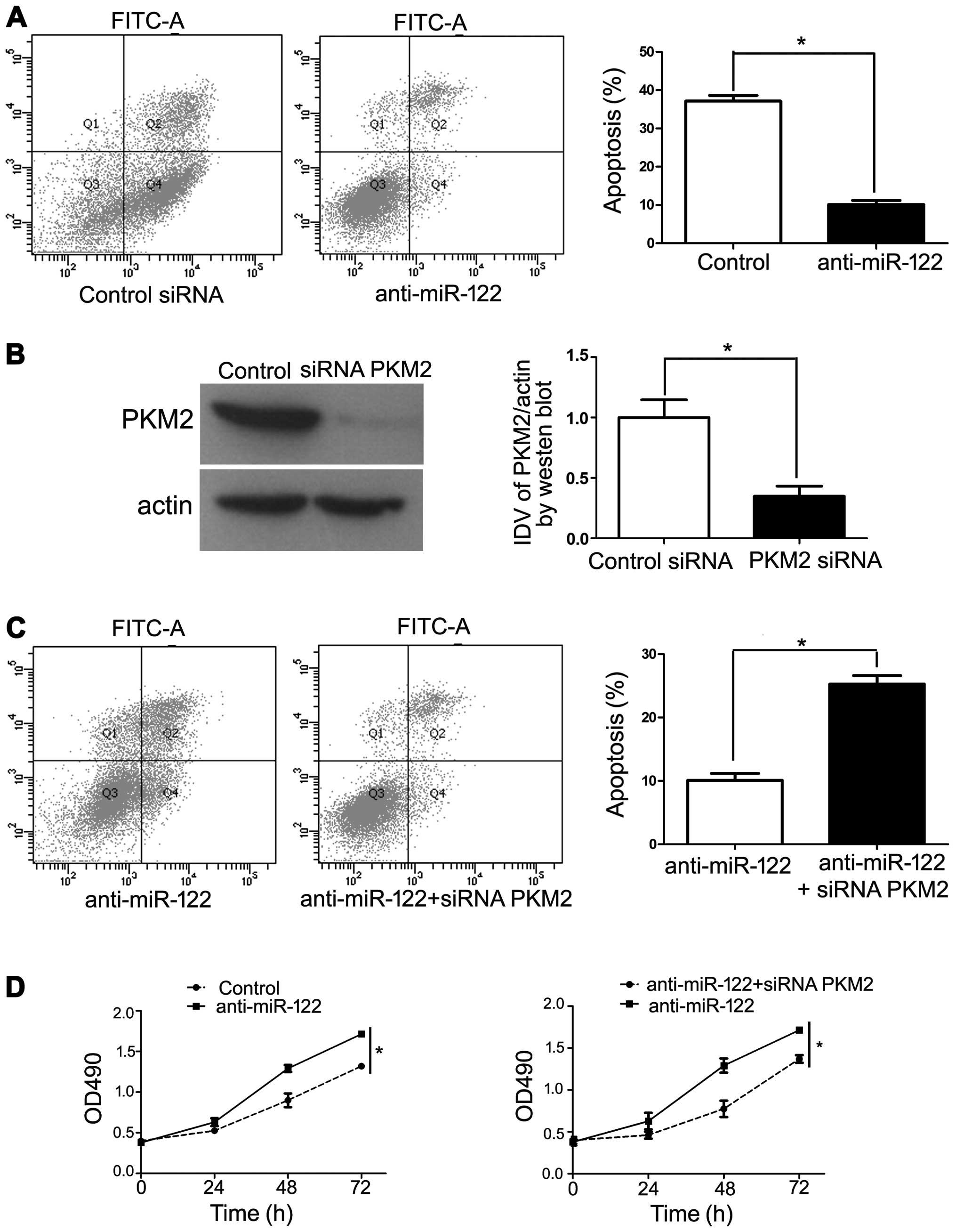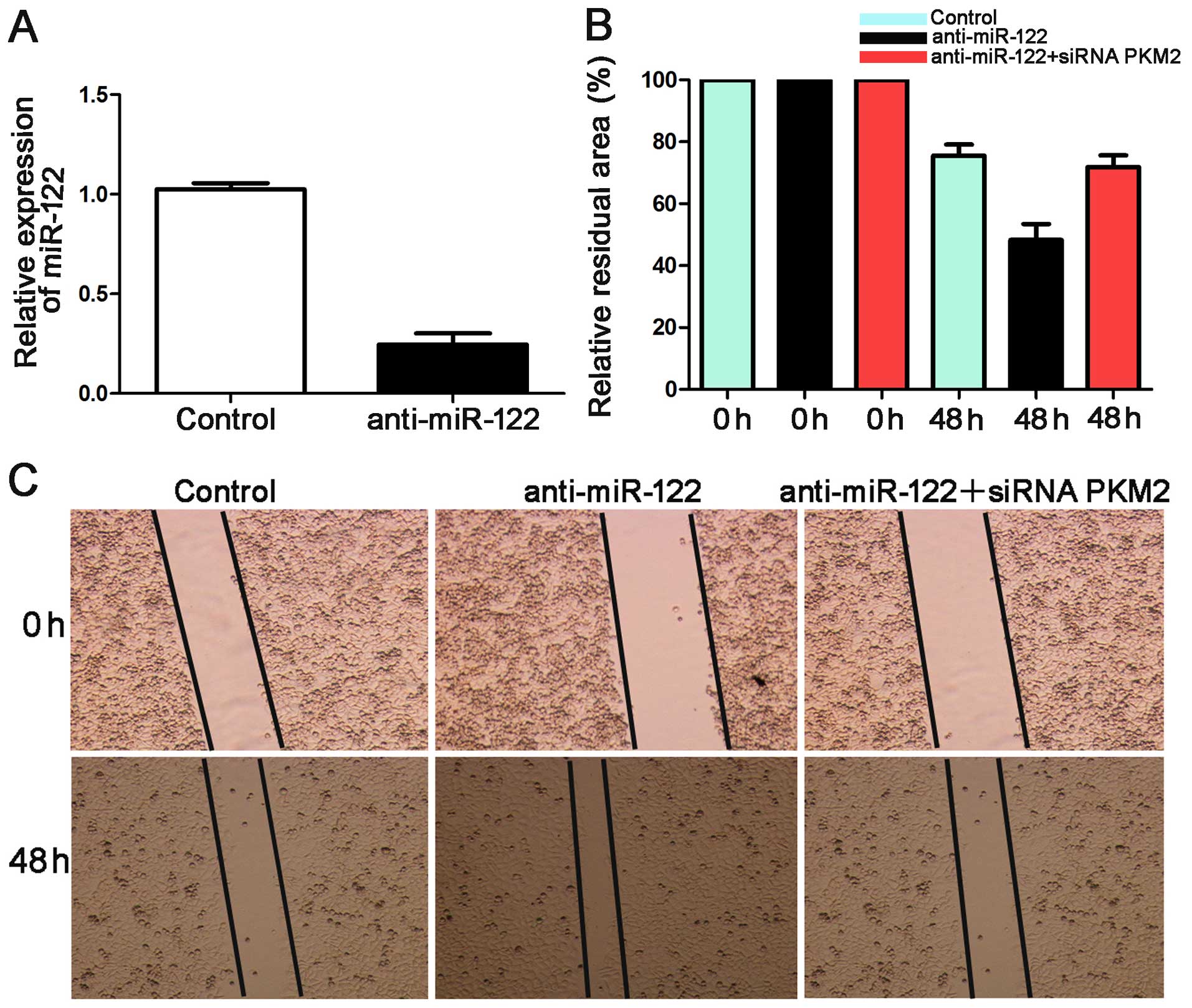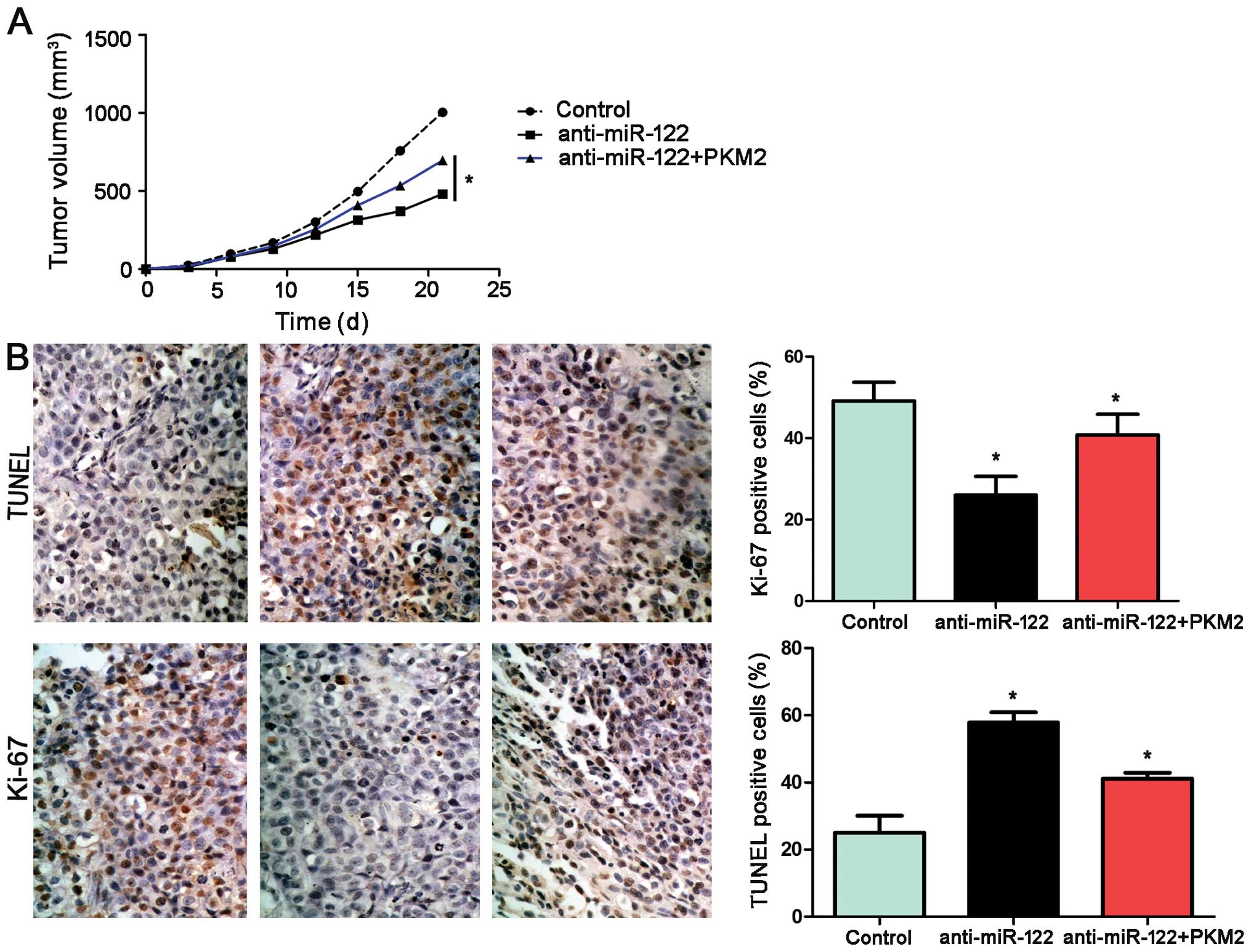MicroRNA-122 affects cell aggressiveness and apoptosis by targeting PKM2 in human hepatocellular carcinoma Corrigendum in /10.3892/or.2021.8073
Retraction in: /10.3892/or.2023.8475
MicroRNA-122 affects cell aggressiveness and apoptosis by targeting PKM2 in human hepatocellular carcinoma
Corrigendum in: /10.3892/or.2021.8073 Retraction in /10.3892/or.2023.8475
- Authors:
- Published online on: August 5, 2015 https://doi.org/10.3892/or.2015.4175
- Pages: 2054-2064
Abstract
Introduction
Human hepatocellular carcinoma (HCC) is a highly invasive tumor with frequent distant metastasis (1), which is the main cause for its poor prognosis. HCC is one of the most common malignancies and the second leading cause of cancer-related mortality in China (2). Its incidence has increased in recent years, yet a satisfactory curative effect has not yet been achieved. Therefore, it is important to elucidate the precise molecular mechanisms of HCC development and to develop new therapeutic targets (3).
Many types of cancer cells require increased glucose uptake, but even in the presence of oxygen, oxidative phosphorylation is decreased (4). This phenomenon of aerobic glycolysis with increased lactate production has been called the Warburg effect (5). Pyruvate kinase (PK), which converts phosphoenolpyruvate into pyruvate, is one of the rate-limiting enzymes in the glycolytic pathway (6). It has four known isoforms, which respectively are M1, M2, L and R. In tumors, expression of PKM2 provides a proliferative advantage in vitro and in vivo (4). PKM2 not only plays a key role in cancer cell metabolism, yet it is also expressed widely in HCC. No matter whether it is in an active tetrameric form or in an inactive dimeric form, PKM2 directly regulates gene transcription (7–10). PKM2 expression is important for cancer cell growth.
MicroRNAs (miRNAs), a large group of evolutionarily conserved non-coding RNAs, negatively regulate genes involved in many fundamental cell processes such as proliferation, development, differentiation, survival and death (11–13). Recent studies have shown that miRNAs play important roles in the progression and initiation of cancer (14). Deregulation of miRNAs has been shown in many types of human cancers including colorectal, lymphoma, breast and lung cancer, glioblastoma and HCC, which suggest it is a hallmark of cancer (15). Specific miRNAs have been reported to regulate various tumor-suppressor genes or oncogenes or function as tumor-suppressor miRs or oncomiRs by directly targeting other genes involved in cell differentiation, invasion, proliferation, angiogenesis and apoptosis in many types of cancer (16). miR-122 is considered to be a novel tumor-related miRNA. Previous research has found that miR-122 is significantly dysregulated in HCC tissues (17–19). Recently, a mouse model with germline deletion of miR-122a exhibited increased epithelial-mesenchymal transition (EMT) in HCC (20). miR-122 was considered to be an angiogenesis suppressor, which further suppressed HCC intrahepatic metastasis (20). Upregulation of miR-122 in HCC cells suppressed the invasion, migration and anchorage-independent growth (21). The above studies suggest that the genes correlated with the expression of miR-122 have functions related to metabolic processes. Thus, miR-122 plays a tumor-suppressive role. In addition, the status, clinical significance and function of miR-122 in HCC remain poorly understood.
In the present study, the association between miR-122, the PKM2 protein and HCC were investigated. We observed that low miR-122 expression is associated with the aggressive phenotype of HCC which is associated with poor prognosis. Inhibition of miR-122 downregulated HCC cell invasion and migration in vitro. Moreover, miR-122 was negatively related to PKM2 in HCC tissues and it interacted with PKM2 directly in the HCC cells. PKM2 knockdown blocked the effect of miR-122 downregulation on apoptosis, migration and invasion in the Hep3B cells. Moreover, restoration of PKM2 expression partially reversed the anticancer effect of miR-122 in vivo. The present study showed that miR-122 suppressed the invasion of HCC cells and inhibited tumor metastasis by targeting PKM2.
Materials and methods
Statement of ethics
The First Affiliated Hospital of the Medical College of Xi'an Jiaotong University Ethics Committee approved all protocols according to the 1975 Declaration of Helsinki and each patient signed an informed consent form.
Clinical samples and cell lines
Sixty HCC and paired normal tumor-adjacent samples (>1.5 cm distant from the margin of the resection) were obtained and used after obtaining informed consent at the Department of Hepatobiliary Surgery, First Affiliated Hospital of the Medical College of Xi'an Jiaotong University from March 2011 to November 2011. Before operation, all patients including 38 males and 22 females (range, 35–71 years; median 49 years) did not receive any radiofrequency ablation, radiotherapy or chemotherapy. HCC tissues and matched normal tumor-adjacent tissues were collected and immediately stored in liquid nitrogen for western blotting or 4% paraformaldehyde solution for immunohistochemistry (IHC) (22). The clinicopathological data and demographic features are shown in Table I.
Table ICorrelation of miR-122 expression and the clinicopathological features of the HCC cases (n=60). |
The human immortal liver cell line LO2 and five HCC cell lines, SMMC7721, MHCC97H, HepG2, Huh7 and Hep3B, were purchased from the Chinese Academy of Sciences (Shanghai, China), and the Institute of Biochemistry and Cell Biology. All the cells were maintained in Dulbecco's modified Eagle's medium (DMEM; Mediatech, USA) containing 10% fetal bovine serum (FBS; Gibco-BRL, USA) and were cultured in a humidified 5% CO2 incubator at 37°C (22,23).
IHC
IHC was carried out on paraformaldehyde-fixed paraffin sections. We used the following antibodies for IHC along with a streptavidin peroxidase conjugate (SP-IHC): PKM2 (#3198; Cell Signaling, Beverly, MA, USA) (1:500) and Ki-67 (#9027; Cell Signaling, Danvers, MA, USA) (1:500). IHC was performed as previously described (3,24). The percentage of positive tumor cells was graded as per the following criteria: 3, >50%; 2, 31–50%; 1, 10–30%; 0, <10% (25).
Transfection
miRNA vectors, including pre-miR negative control, pre-miR-122, anti-miR-122 (miR-122 inhibitor) and the negative control for anti-miR-122 were obtained from GeneCopoeia (Guangzhou, China). The overexpression vectors containing wild-type PKM2 (Myc-DDK-tagged) were purchased from OriGene. siRNA PKM2 was obtained from Santa Cruz Biotechnology (sc-62820; Santa Cruz, CA, USA).
The mutant 3′-untranslated region (3′-UTR) of PKM2 and the 3′-UTR of PKM2 siRNA were purchased from Sangon Biotech (Shanghai, China). The sequences of the siRNAs and primers used are listed in Table II. We used Lipofectamine 2000 to transfect the cells with the siRNA and vectors according to the manufacturer's instructions (23) (Invitrogen, Carlsbad, CA, USA).
Western blotting
For the immunoblotting assays, we used the following primary antibodies: PKM2 (1:1,000) and actin (#3700; Cell Signaling, Beverly, MA, USA) (1:5,000). Horseradish peroxidase-conjugated goat anti-rabbit or anti-mouse secondary antibodies (Bio-Rad, Hercules, CA, USA) were used at a 1:5,000 dilution and a Western Blotting Luminol Reagent (sc-2048; Santa Cruz Biotechnology) was used to detect the results as described in our previous studies (4,25).
Real-time quantitative reverse transcription-polymerase chain reaction (qRT-PCR)
We used TaqMan human miRNA assay kit and TaqMan miRNA reverse transcription kit (both from Applied Biosystems, Foster City, CA, USA) to perform the quantification of the levels of miR-122 and U6. The relative quantitative expression of miR-122 is expressed as a fold difference relative to U6.
3-(4,5-Dimethyl-2-thiazolyl)-2,5-diphenyl-2-H-tetrazolium bromide assay
We determined the cell viability using the 3-(4,5-dimethylthiazol-2-yl)-2,5-diphenyl tetrazolium bromide assay (MTT; Roche Diagnostics, USA) (22). Cell viability was calculated at 24, 48 and 72 h after transfection. We measured the absorbance of the samples using a Model 550 microplate reader (Bio-Rad Laboratories, USA). Three or more independent repeated experiments were performed.
Luciferase reporter assay
The 3′-UTR sequence of PKM2 was predicted to interact with miR-122. Thus, we synthesized a corresponding mutated sequence within the predicted target sites and inserted it into the pRL-TK control vector (Promega, Madison, WI, USA). Hep3B cells which were transfected with 100 ng anti-miR-122 and negative control or pre-miR-122 were then seeded into a 96-well plate. After 24 h, we cotransfected the cells with 30 ng of the wild-type PKM2 siRNA and mutant 3′-UTR of PKM2 siRNA or the wild-type PKM2 and mutant 3′-UTR of PKM2 using 0.45 µl of FuGENE (Promega). Cells were collected and then measured according to the manufacturer's instructions (Dual-Luciferase Assay System; Promega) after 48 h (25). As an internal control, pRL-TK expressing Renilla luciferase was cotransfected to correct the differences between both transfection and harvest efficiencies (25).
Flow cytometry
We analyzed cell apoptosis using the Annexin V-FLUOS staining kit (Roche, USA) after a 48-h transfection (22). Briefly, the samples were analyzed by BD FACSCanto II flow cytometer (Becton-Dickinson, USA). Three independent repeated experiments were performed.
Wound healing assay
The cells were seeded in 6-well plates forming a cell monolayer. After 12 h, we used a 200-µl sterile plastic tip to create a wound line on the plate surface, and then scoured off the suspension of cells with DMEM. The cells were cultured at 37°C for 48 h in DMEM in a humidified incubator containing 5% CO2 (22), and then a phase-contrast microscope was used to capture images.
Transwell assay
We coated Transwell inserts (Nalge Nunc, Naperville, IL, USA) with Matrigel (BD Biosciences, USA) on the inner layer at 1 mg/ml. Forty-eight hours after transfection, HepG2 cells (200 µl) were added into the upper chamber at 2.5×105/ml. In addition, 750 µl DMEM which contained 10% FBS was added into the lower chamber. After 24 h, we first fixed the HepG2 cells in 4% paraformaldehyde for 3 min, and then permeabilized them in methanol for 25 min. After the above, we softly removed the cells which were on the inner layer with a cotton swab, and stained the cells on the undersurface of the insert with 0.3% crystal violet dye for 15 min (22). Phosphate-buffered saline (PBS) was used to wash the filters, and images were captured by a light microscope.
In vivo experiments
We used female BALB/c nude mice (4- to 6-weeks old) (Centre of Laboratory Animals, Zhejiang Provincial People's Hospital, Hangzhou, China) to establish a nude mouse xenograft model. Mice (2 animals/cage) were housed in a sterilized cage at a constant humidity and temperature and we fed the mice on a regular autoclaved chow diet with water ad libitum (25). As described at the American Type Culture Collection (ATCC), HepG2 is not a tumorigenic cell line. We inoculated 4–5×106 Hep3B cells subcutaneously into the flank of each nude mouse. The tumor volume was determined by measuring two of its dimensions and was calculated as tumor volume = length × width × width/2 (25). After 3 weeks, we used a terminal deoxynucleotidyl transferase-mediated dUTP nick-end labeling (TUNEL) assay kit (4810-30-K; R&D Systems, Minneapolis, MN, USA) to detect the amount of apoptosis in the tumor tissues according to the manufacturer's guidelines (25). Furthermore, all animal protocols were approved by the Institutional Animal Care and Use Committee of Zhejiang Provincial People's Hospital, Zhejiang.
Statistical analysis
All data are presented as the mean ± SEM. SPSS (SPSS, Inc., Chicago, IL, USA) was used for the multi-variant Cox regression analysis and the Pearson's Chi-square tests. GraphPad Prism 6 software (GraphPad Software, Inc., San Diego, CA, USA) was used to evaluate statistical significance. P<0.05 was considered to indicate a statistically significant result.
Results
miR-122 is frequently downregulated in HCC tissues and is correlated with patient prognosis
To determine the expression of miR-122 in the HCC tissues, we evaluated miR-122 mRNA in 60 paired HCC and para-cancerous tissues using qPCR. Notably, miR-122 was downregulated in 85% (51/60) of the examined HCC tissues (Fig. 1A). Next, we analyzed the levels of miR-122 in several HCC cell lines, including HepG2, Huh7, Hep3B, SMMC7721 and MHCC97H, and the normal human liver cell line LO2. Consistent with the above results, qPCR analysis revealed a similar decrease in miR-122 in multiple HCC cell lines compared with the LO2 cells (Fig. 1B).
Then, we aimed to ascertain whether miR-122 inhibition is related to HCC clinical features or prognosis. A relationship between decreased miR-122 expression and intrahepatic metastasis, advanced tumor-node-metastasis (TNM) stage and high Edmonson's pathological classification was observed (Table I). Furthermore, a low miR-122 level was associated with reduced overall survival (OS) time (P=0.0258) as determined by the Kaplan-Meier method (Fig. 2). We further performed Cox proportional hazards regression analysis to exclude the confounder effect.
First, we used univariate analysis to identify factors that affected the 3-year OS time. Then, multivariate analysis was used to control potential confounders (Table III). Using Kaplan-Meier analysis, we found that the patients with negative miR-122 expression had poor OS prognosis (P=0.040) (Table III). We next evaluated the levels of miR-122 in HCC tissues with or without metastasis. The level of miR-122 in the HCC tissues of patients with metastasis was lower than that in the tissues of patients without metastasis (Fig. 1C), suggesting that a low miR-122 expression level is related to metastasis in patients with HCC. This result indicates that the loss of miR-122 contributes to metastasis of HCC. Collectively, these data revealed that miR-122 inhibition promotes the development of HCC.
PKM2 has a negative correlation with miR-122 expression
We further analyzed the association between the miR-122 level, and PKM2 expression in human HCC tissues. Samples from 60 HCC cases, in which miR-122 levels had been previously determined, were immunohistochemically analyzed for PKM2 expression (Fig. 3A). We confirmed a negative relationship between the expression of miR-122 and PKM2 in the HCC tissues, indicating that miR-122 downregulation was significantly associated with high PKM2 levels (r=0.49, P=0.006, Fig. 3B).
miR-122 directly regulates PKM2 expression in Hep3B cells
We found that the public miRNA database (TargetScan) predicted that PKM2 may be a target for miR-122, and the 3′-UTR of PKM2 contains a highly conserved binding site for miR-122 (Fig. 4A). To determine whether miR-122 targets PKM2 in HCC, we transfected the pre-miR-122 and anti-miR-122 into Hep3B cells. The overexpression of miR-122 significantly downregulated PKM2 protein expression. Furthermore, the knockdown of endogenous miR-122 recovered the PKM2 protein expression (Fig. 4B). Moreover, this prediction was validated using dual-luciferase reporter gene assays in Hep3B cells. Cotransfection of miR-122 significantly suppressed the activity of a luciferase reporter containing the wild-type 3′-UTR of PKM2 but not that of the mutant reporter (Fig. 4C). In addition, inhibition of endogenous miR-122 by anti-miR-122 led to increased luciferase activity of the wild-type reporter but not the mutant reporter (Fig. 4D). Together, these data suggest that miR-122 negatively regulates the expression of PKM2 by directly targeting its 3′-UTR.
miR-122 inhibits cell proliferation and induces apoptosis by targeting PKM2 in Hep3B
We transfected specific anti-miR-122 to knockdown miR-122 in Hep3B cells and conducted a cell apoptosis analysis using flow cytometry and MTT assay. The results revealed that transfection of anti-miR-122 decreased Hep3B cell apoptosis (Fig. 5A). In order to confirm the requirement of PKM2 in anti-miR-122-inhibited cell apoptosis, we cotransfected anti-miR-122 along with a functional siRNA targeting PKM2, which repressed endogenous PKM2 levels (Fig. 5B). Under these conditions, we observed a significant increase in anti-miR-122-inhibited cell apoptosis (P<0.05), which is in accordance with PKM2 induction being critical for this effect (Fig. 5C and D). Collectively, our results revealed that downregulation of miR-122 increased PKM2 expression, thereby promoting HCC progression.
miR-122 suppresses cell migration and invasion by targeting PKM2 in Hep3B
Mechanical scrape wound healing and Transwell models were used to determine whether miR-122 suppresses HCC cell migration and invasion. We suppressed the expression level of miR-122 in Hep3B cells. qRT-PCR showed that the expression of miR-122 was downregulated by anti-miR-122 (P<0.05, Fig. 6A).
In the wound healing assay, the anti-miR-122 group showed a larger relative residual area than the control group for the Hep3B cells. The group co-transfected with anti-miR-122 along with a functional siRNA targeting PKM2 was larger than that of the anti-miR-122 group (P<0.05, Fig. 6B and C). Additionally, the number of invaded Hep3B cells in the anti-miR-122 group was significantly more than the control group (P<0.05, Fig. 7). These effects were recovered by co-transfecting anti-miR-122 along with siRNA PKM2 (P<0.05, Figs. 6B and C, and 7). Together these data suggest that miR-122 inhibits tumor metastasis in HCC by targeting PKM2.
miR-122 inhibits tumor growth by targeting PKM2 in mice
Using an Hep3B subcutaneous tumor model, we aimed to ascertain whether miR-122 affects tumor growth. Mice were treated with miR-122+PKM2, miR-122 or miR-control by multicenter intratumoral injection. Tumor growth curves revealed that restoration of PKM2 expression partially restored tumor growth. For the miR-122-overexpressing Hep3B cells, tumor growth curves of the tumor models revealed that miR-122 slowed down tumor growth in mice, and re-expression of PKM2 partially restored tumor growth (P<0.05, Fig. 8A). Furthermore, we performed TUNEL assays and IHC for Ki-67 in the xenografted tissues. As expected, miR-122 overexpression induced apoptosis and inhibited proliferation in vivo. PKM2 not only partially abolished the inhibitory effect of miR-122 on HCC growth; yet also reduced cell apoptosis significantly and increased the number of cells staining positive for Ki-67, which was in accordance with our in vitro observations (P<0.05, respectively, Fig. 8B).
Taken together, these data indicate that PKM2 functions as a downstream factor in miR-122-induced apoptosis and growth arrest in HCC.
Discussion
Hepatocellular carcinoma (HCC) is rarely diagnosed in the early stage, since when symptoms emerge, the patient is often already in an advanced stage (26). Recently, certain HCC-associated oncogenes have been found to be associated with the prognosis of HCC (22,27,28). Yet, the exact molecular mechanism of HCC progression remains unclear.
PKM2 is a critical enzyme that controls the rate-limiting step of glycolysis and plays a key role in the metabolism of cancer progression. It has been demonstrated that, in glioma cells, PKM2 knockdown induced cell apoptosis and inhibited cell growth, metabolic activity, cellular invasion, and glutathione and ATP levels (4,29). Knockdown of PKM2 in lung tumors promoted cancer cell apoptosis and inhibited tumor growth in vivo and in vitro (4,30). All of these findings suggest an important role of PKM2 in tumorigenesis.
It has been established that miRNAs regulate hepatocarcinogenesis-related gene expression, indicating a new molecular mechainism of HCC initiation and progression (23,31–34). Recently, miR-122 was identified as a robust biomarker of HCC with high positive predictive value (35). miR-122 plays a key role in the maintenance of normal physiological metabolism in the liver. Low expression of miR-122 is frequently implicated in hepatocarcinogenesis and tumor metastasis (18–20). Studies have found that miR-122 targets pyruvate kinase M2 and affects the metabolism of HCC (20). While, to date, there are no studies on miR-122 in the regulation of cell apoptosis, migration and invasion by targeting PKM2 in HCC.
First, the expression levels of miR-122 in 60 pairs of HCC tissues and adjacent non-tumor tissues were detected. Quantification of the data showed that miR-122 expression in the tumor tissues was significantly lower than that in the non-tumor tissues. Next, we analyzed the levels of miR-122 in five HCC cell lines. qPCR analysis indicated a similar decrease in miR-122 in multiple HCC cell lines when compared with that in LO2 cells. Our results showed that miR-122 downregulation was associated with HCC patient clinical features and prognosis. An association between decreased miR-122 expression and intrahepatic metastasis, advanced tumor-node-metastasis (TNM) stage and high Edmonson pathological classification was observed. A low miR-122 level was associated with reduced overall survival (OS). These data suggest that the development of HCC could be inhibited by deregulation of miR-122.
The public miRNA database (TargetScan) predicted that PKM2 may be one of the targets of miR-122, and 3′-UTR of PKM2 contains a highly conserved binding site for miR-122. Thus, we analyzed the association between the miR-122 level and PKM2 expression in HCC. First, we confirmed a negative relationship between the expression of miR-122 and PKM2 in HCC tissues, indicating that miR-122 downregulation is significantly associated with a high PKM2 level. Then we transfected the pre-miR-122 and anti-miR-122 into Hep3B cells. The data indicated that downregulation of miR-122 inhibited Hep3B cell apoptosis, yet induced cell migration and invasion. Moreover, the overexpression of miR-122 significantly down-regulated PKM2 protein expression and the knockdown of endogenous miR-122 recovered the PKM2 protein expression. In addition, RNA silencing of PKM2 significantly increased miR-122 inhibitor-mediated Hep3B cell apoptosis and reduced miR-122 inhibitor-mediated Hep3B cell migration and invasion.
Furthermore, immunostaining of Ki-67 and TUNEL assays indicated that miR-122 suppressed tumor growth by inducing apoptosis and growth arrest in vivo. PKM2 partially abolished the inhibitory effect of miR-122 on HCC growth.
From the above findings, we found that miR-122 was downregulated in HCC tissues, particularly in aggressive tumor tissues. There is a correlative relationship between low expression of miR-122 and poor prognostic features in HCC. Moreover, miR-122 interacts with PKM2 in HCC. We demonstrated that downregulation of miR-122 inhibited cell apoptosis and promoted migration by restoring PKM2 expression in vitro and in vivo. Taken together, miR-122 may play an anti-onco-miRNA role in HCC. It may also be a potential therapeutic target of HCC.
In conclusion, miR-122 has a low expression in HCC tissues, and its downregulation in HCC is associated with poor clinicopathological features. Furthermore, we demonstrated that negative expression of miR-122 is related with a reduced 3-year OS time of HCC patients after surgery. Univariate and multivariate Cox repression analyses indicated that low-miR-122 is a risk factor for predicting a poor prognosis of HCC patients after hepatectomy. In vitro, we proved that downregulation of miR-122 inhibited cell proliferation, migration and invasion, and induced apoptosis in Hep3B cells. A negative correlation between miR-122 and PKM2 expression was observed in the HCC tissues. Intriguingly, downregulation of miR-122 upregulated PKM2 expression and upregulation of miR-122 decreased PKM2 expression. PKM2 was identified as a direct target of miR-122 in HCC. PKM2 knockdown can abolish the effect of miR-122 downregulation on the metastasis in HCC. Moreover, the inhibitory effect of miR-122 on HCC growth was partially abolished by PKM2, which suggests that miR-122 functions as an anti-oncogene by downregulating PKM2. The present study demonstrated that miR-122 plays an important role in the invasion and metastasis of HCC by targeting PKM2.
Acknowledgments
The present study was supported by the Zhejiang Provincial Natural Science Foundation of China (grant LY13H150009).
References
|
Fang JH, Zhou HC, Zeng C, Yang J, Liu Y, Huang X, Zhang JP, Guan XY and Zhuang SM: MicroRNA-29b suppresses tumor angiogenesis, invasion, and metastasis by regulating matrix metalloproteinase 2 expression. Hepatology. 54:1729–1740. 2011. View Article : Google Scholar : PubMed/NCBI | |
|
Tu K, Zheng X, Zhou Z, Li C, Zhang J, Gao J, Yao Y and Liu Q: Recombinant human adenovirus-p53 injection induced apoptosis in hepatocellular carcinoma cell lines mediated by p53-Fbxw7 pathway, which controls c-Myc and cyclin E. PLoS One. 8:e685742013. View Article : Google Scholar : PubMed/NCBI | |
|
Xu Q, Liu X, Zheng X, Yao Y, Wang M and Liu Q: The transcriptional activity of Gli1 is negatively regulated by AMPK through Hedgehog partial agonism in hepatocellular carcinoma. Int J Mol Med. 34:733–741. 2014.PubMed/NCBI | |
|
Xu Q, Liu X, Zheng X, Yao Y and Liu Q: PKM2 regulates Gli1 expression in hepatocellular carcinoma. Oncol Lett. 8:1973–1979. 2014.PubMed/NCBI | |
|
Warburg O: On the origin of cancer cells. Science. 123:309–314. 1956. View Article : Google Scholar : PubMed/NCBI | |
|
Sun Y, Zhao X, Zhou Y and Hu Y: miR-124, miR-137 and miR-340 regulate colorectal cancer growth via inhibition of the Warburg effect. Oncol Rep. 28:1346–1352. 2012.PubMed/NCBI | |
|
Christofk HR, Vander Heiden MG, Harris MH, Ramanathan A, Gerszten RE, Wei R, Fleming MD, Schreiber SL and Cantley LC: The M2 splice isoform of pyruvate kinase is important for cancer metabolism and tumour growth. Nature. 452:230–233. 2008. View Article : Google Scholar : PubMed/NCBI | |
|
Yang W, Xia Y, Hawke D, Li X, Liang J, Xing D, Aldape K, Hunter T, Alfred Yung WK and Lu Z: PKM2 phosphorylates histone H3 and promotes gene transcription and tumorigenesis. Cell. 150:685–696. 2012. View Article : Google Scholar : PubMed/NCBI | |
|
Gao X, Wang H, Yang JJ, Liu X and Liu ZR: Pyruvate kinase M2 regulates gene transcription by acting as a protein kinase. Mol Cell. 45:598–609. 2012. View Article : Google Scholar : PubMed/NCBI | |
|
Yang W and Lu Z: Regulation and function of pyruvate kinase M2 in cancer. Cancer Lett. 339:153–158. 2013. View Article : Google Scholar : PubMed/NCBI | |
|
Rosa A and Brivanlou AH: MicroRNAs in early vertebrate development. Cell Cycle. 8:3513–3520. 2009. View Article : Google Scholar : PubMed/NCBI | |
|
Harfe BD: MicroRNAs in vertebrate development. Curr Opin Genet Dev. 15:410–415. 2005. View Article : Google Scholar : PubMed/NCBI | |
|
Croce CM and Calin GA: miRNAs, cancer, and stem cell division. Cell. 122:6–7. 2005. View Article : Google Scholar : PubMed/NCBI | |
|
Lu J, Getz G, Miska EA, Alvarez-Saavedra E, Lamb J, Peck D, Sweet-Cordero A, Ebert BL, Mak RH, Ferrando AA, et al: MicroRNA expression profiles classify human cancers. Nature. 435:834–838. 2005. View Article : Google Scholar : PubMed/NCBI | |
|
Baer C, Claus R and Plass C: Genome-wide epigenetic regulation of miRNAs in cancer. Cancer Res. 73:473–477. 2013. View Article : Google Scholar : PubMed/NCBI | |
|
Jia Z, Wang K, Wang G, Zhang A and Pu P: miR-30a-5p antisense oligonucleotide suppresses glioma cell growth by targeting SEPT7. PLoS One. 8:e550082013. View Article : Google Scholar : PubMed/NCBI | |
|
Burchard J, Zhang C, Liu AM, Poon RT, Lee NP, Wong KF, Sham PC, Lam BY, Ferguson MD, Tokiwa G, et al: microRNA-122 as a regulator of mitochondrial metabolic gene network in hepatocellular carcinoma. Mol Syst Biol. 6:4022010. View Article : Google Scholar : PubMed/NCBI | |
|
Tsai WC, Hsu SD, Hsu CS, Lai TC, Chen SJ, Shen R, Huang Y, Chen HC, Lee CH, Tsai TF, et al: MicroRNA-122 plays a critical role in liver homeostasis and hepatocarcinogenesis. J Clin Invest. 122:2884–2897. 2012. View Article : Google Scholar : PubMed/NCBI | |
|
Tsai WC, Hsu PW, Lai TC, Chau GY, Lin CW, Chen CM, Lin CD, Liao YL, Wang JL, Chau YP, et al: MicroRNA-122, a tumor suppressor microRNA that regulates intrahepatic metastasis of hepatocellular carcinoma. Hepatology. 49:1571–1582. 2009. View Article : Google Scholar : PubMed/NCBI | |
|
Liu AM, Xu Z, Shek FH, Wong KF, Lee NP, Poon RT, Chen J and Luk JM: miR-122 targets pyruvate kinase M2 and affects metabolism of hepatocellular carcinoma. PLoS One. 9:e868722014. View Article : Google Scholar : PubMed/NCBI | |
|
Bai S, Nasser MW, Wang B, Hsu SH, Datta J, Kutay H, Yadav A, Nuovo G, Kumar P and Ghoshal K: MicroRNA-122 inhibits tumorigenic properties of hepatocellular carcinoma cells and sensitizes these cells to sorafenib. J Biol Chem. 284:32015–32027. 2009. View Article : Google Scholar : PubMed/NCBI | |
|
Li C, Yang W, Zhang J, Zheng X, Yao Y, Tu K and Liu Q: SREBP-1 has a prognostic role and contributes to invasion and metastasis in human hepatocellular carcinoma. Int J Mol Sci. 15:7124–7138. 2014. View Article : Google Scholar : PubMed/NCBI | |
|
Tu K, Zheng X, Dou C, Li C, Yang W, Yao Y and Liu Q: MicroRNA-130b promotes cell aggressiveness by inhibiting peroxisome proliferator-activated receptor gamma in human hepatocellular carcinoma. Int J Mol Sci. 15:20486–20499. 2014. View Article : Google Scholar : PubMed/NCBI | |
|
Huang Y, Guo W and Kan H: TPX2 is a prognostic marker and contributes to growth and metastasis of human hepatocellular carcinoma. Int J Mol Sci. 15:18148–18161. 2014. View Article : Google Scholar : PubMed/NCBI | |
|
Tu K, Yang W, Li C, Zheng X, Lu Z, Guo C, Yao Y and Liu Q: Fbxw7 is an independent prognostic marker and induces apoptosis and growth arrest by regulating YAP abundance in hepatocellular carcinoma. Mol Cancer. 13:1102014. View Article : Google Scholar : PubMed/NCBI | |
|
Bolondi L, Sofia S, Siringo S, Gaiani S, Casali A, Zironi G, Piscaglia F, Gramantieri L, Zanetti M and Sherman M: Surveillance programme of cirrhotic patients for early diagnosis and treatment of hepatocellular carcinoma: A cost effectiveness analysis. Gut. 48:251–259. 2001. View Article : Google Scholar : PubMed/NCBI | |
|
Zhang Y, Gong W, Dai S, Huang G, Shen X, Gao M, Xu Z, Zeng Y and He F: Downregulation of human farnesoid X receptor by miR-421 promotes proliferation and migration of hepatocellular carcinoma cells. Mol Cancer Res. 10:516–522. 2012. View Article : Google Scholar : PubMed/NCBI | |
|
He Z, Wu J, Dang H, Lin H, Zheng H and Zhong D: Polo-like kinase 1 contributes to the tumorigenicity of BEL-7402 hepatoma cells via regulation of Survivin expression. Cancer Lett. 303:92–98. 2011. View Article : Google Scholar : PubMed/NCBI | |
|
Kefas B, Comeau L, Erdle N, Montgomery E, Amos S and Purow B: Pyruvate kinase M2 is a target of the tumor-suppressive microRNA-326 and regulates the survival of glioma cells. Neuro Oncol. 12:1102–1112. 2010. View Article : Google Scholar : PubMed/NCBI | |
|
Shi HS, Li D, Zhang J, Wang YS, Yang L, Zhang HL, Wang XH, Mu B, Wang W, Ma Y, et al: Silencing of pkm2 increases the efficacy of docetaxel in human lung cancer xenografts in mice. Cancer Sci. 101:1447–1453. 2010. View Article : Google Scholar : PubMed/NCBI | |
|
Petrelli A, Perra A, Cora D, Sulas P, Menegon S, Manca C, Migliore C, Kowalik MA, Ledda-Columbano GM, Giordano S, et al: MicroRNA/gene profiling unveils early molecular changes and nuclear factor erythroid related factor 2 (NRF2) activation in a rat model recapitulating human hepatocellular carcinoma (HCC). Hepatology. 59:228–241. 2014. View Article : Google Scholar | |
|
Ameres SL and Zamore PD: Diversifying microRNA sequence and function. Nat Rev Mol Cell Biol. 14:475–488. 2013. View Article : Google Scholar : PubMed/NCBI | |
|
Yang L, Belaguli N and Berger DH: MicroRNA and colorectal cancer. World J Surg. 33:638–646. 2009. View Article : Google Scholar : PubMed/NCBI | |
|
Tazawa H, Tsuchiya N, Izumiya M and Nakagama H: Tumor-suppressive miR-34a induces senescence-like growth arrest through modulation of the E2F pathway in human colon cancer cells. Proc Natl Acad Sci USA. 104:15472–15477. 2007. View Article : Google Scholar : PubMed/NCBI | |
|
Jung CJ, Iyengar S, Blahnik KR, Ajuha TP, Jiang JX, Farnham PJ and Zern M: Epigenetic modulation of miR-122 facilitates human embryonic stem cell self-renewal and hepatocellular carcinoma proliferation. PLoS One. 6:e277402011. View Article : Google Scholar : PubMed/NCBI |



